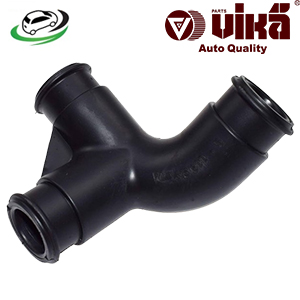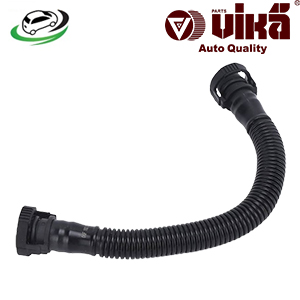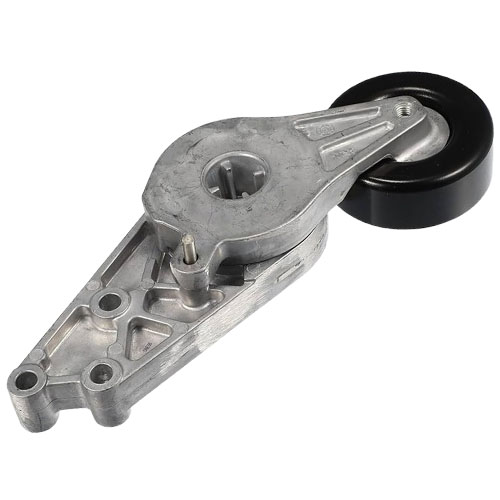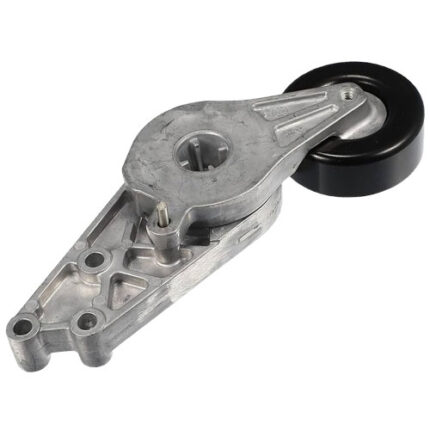-14%
Get AUDI A4 B6 (8E2) Timing Belt Tensioner Assembly 06B903133A in Kenya
The timing belt tensioner assembly is a crucial component of an internal combustion engine’s timing system. It ensures the proper tension of the timing belt, which is responsible for synchronizing the rotation of the crankshaft and camshaft(s). This synchronization is vital for maintaining the correct timing of valve openings and closings in relation to the engine’s piston movements. A well-functioning timing belt tensioner assembly is essential for optimal engine performance, longevity, and reliability. This comprehensive overview explores the function, importance, types, common issues, maintenance, and consequences of a malfunctioning timing belt tensioner assembly.
Function of the Timing Belt Tensioner Assembly
The timing belt tensioner assembly performs several key functions:
- Maintaining Belt Tension: The primary function of the timing belt tensioner assembly is to maintain the correct tension of the timing belt. Proper tension is crucial for the smooth operation of the timing system and to prevent slippage or excessive wear.
- Compensating for Wear: As the timing belt ages and undergoes wear and stretching, the tensioner assembly compensates for these changes by adjusting the tension of the belt. This ensures that the timing belt remains correctly aligned and tensioned throughout its service life.
- Preventing Belt Slippage: By maintaining proper tension, the timing belt tensioner assembly prevents the belt from slipping on the pulleys. Slippage can lead to incorrect timing, which can cause engine performance issues or damage.
- Reducing Noise and Vibration: A properly functioning tensioner assembly helps reduce noise and vibration caused by the timing belt. It ensures smooth and quiet operation of the engine’s timing system.
- Protecting Engine Components: The tensioner assembly helps protect other engine components from damage by ensuring that the timing belt operates within its specified parameters. This prevents excessive stress and wear on the camshaft, crankshaft, and other related parts.
Importance of the Timing Belt Tensioner Assembly
The timing belt tensioner assembly is vital for several reasons:
- Engine Performance: Proper tensioning of the timing belt is essential for maintaining accurate timing between the crankshaft and camshaft(s). This ensures optimal engine performance, including efficient power delivery and smooth operation.
- Preventing Engine Damage: Incorrect timing due to a malfunctioning tensioner assembly can lead to serious engine damage, such as bent valves, piston damage, or internal component failure. Maintaining proper tension helps prevent such issues.
- Extending Timing Belt Life: A well-functioning tensioner assembly helps extend the service life of the timing belt by preventing excessive wear and ensuring that it operates within its designed specifications.
- Reducing Maintenance Costs: By ensuring the proper operation of the timing belt, the tensioner assembly helps reduce the likelihood of premature belt failure and costly repairs. Regular maintenance of the tensioner can prevent more extensive engine damage and associated expenses.
- Enhancing Reliability: The timing belt tensioner assembly contributes to the overall reliability of the engine. Properly maintained timing components ensure consistent engine performance and reduce the risk of unexpected breakdowns.
Types of Timing Belt Tensioner Assemblies
There are several types of timing belt tensioner assemblies, each designed for specific applications and engine configurations:
- Spring-Loaded Tensioners:
- Description: Spring-loaded tensioners use a coil spring to apply tension to the timing belt. The spring’s force keeps the belt at the correct tension and compensates for belt stretch and wear.
- Function: These tensioners are commonly used in many vehicles due to their simplicity and effectiveness. They are typically adjustable to accommodate changes in belt tension over time.
- Hydraulic Tensioners:
- Description: Hydraulic tensioners use hydraulic pressure to apply and maintain tension on the timing belt. They are equipped with a hydraulic piston and a spring mechanism to provide precise tension control.
- Function: Hydraulic tensioners offer more consistent tensioning and are often used in high-performance or modern engines. They require a source of engine oil to operate and may include an oil-filled chamber or an external oil line.
- Automatic Tensioners:
- Description: Automatic tensioners are designed to adjust the tension of the timing belt automatically without the need for manual adjustment. They often use a combination of spring and hydraulic mechanisms.
- Function: These tensioners are popular in modern vehicles for their convenience and reliability. They continuously adjust the tension to accommodate changes in belt length and engine conditions.
- Manual Tensioners:
- Description: Manual tensioners require manual adjustment to set the proper tension on the timing belt. They are typically used in older engine designs or specific applications.
- Function: Manual tensioners allow for precise adjustment but require periodic checks and adjustments by the vehicle owner or mechanic.
Common Issues with Timing Belt Tensioner Assemblies
Timing belt tensioner assemblies can experience several issues over time due to wear, contamination, or mechanical failure. Common problems include:
- Worn-Out Tensioner: Over time, the tensioner assembly itself can wear out, leading to improper tensioning of the timing belt. Worn tensioners may fail to maintain the correct tension, causing belt slippage or noise.
- Hydraulic Leaks: For hydraulic tensioners, leaks in the hydraulic system can lead to a loss of pressure and reduced tensioning ability. Leaking hydraulic fluid can also lead to engine oil contamination.
- Spring Failure: In spring-loaded tensioners, the coil spring can weaken or break over time, leading to insufficient tension on the timing belt. This can cause belt slippage or premature wear.
- Noise and Vibration: A failing tensioner assembly may produce unusual noises, such as squealing or rattling, due to improper tensioning or misalignment. Increased vibration can also be a sign of a problem.
- Misalignment: If the tensioner assembly becomes misaligned or if the mounting bolts become loose, it can cause improper tensioning and affect the timing belt’s performance.
Signs of a Failing Timing Belt Tensioner Assembly
Recognizing the signs of a failing timing belt tensioner assembly is crucial for timely maintenance and avoiding engine damage. Common symptoms include:
- Engine Noise: Unusual noises, such as squealing or rattling, coming from the engine may indicate a problem with the tensioner assembly. These noises can result from improper tensioning or a worn-out tensioner.
- Check Engine Light: The check engine light may illuminate if the engine control unit detects issues related to the timing belt or tensioner assembly. This may be accompanied by trouble codes related to timing or belt tension.
- Timing Belt Slippage: If the timing belt is slipping or has visible signs of wear, it may be due to a malfunctioning tensioner. Slippage can lead to poor engine performance and timing issues.
- Poor Engine Performance: A failing tensioner assembly can affect engine performance, including reduced power, rough idling, or difficulty starting the engine. These symptoms may indicate a problem with the timing system.
- Vibration and Engine Shaking: Excessive vibration or shaking of the engine can be a sign of a faulty tensioner assembly. Misalignment or improper tensioning can cause the engine to run unevenly.
Maintenance and Replacement of the Timing Belt Tensioner Assembly
Proper maintenance and timely replacement of the timing belt tensioner assembly are essential for ensuring the engine operates efficiently. Key practices include:
- Regular Inspection: Periodically inspect the timing belt tensioner assembly for signs of wear, damage, or leaks. Check the tension of the timing belt and ensure that the tensioner is functioning correctly.
- Replace Worn Components: If the tensioner assembly shows signs of wear, such as noise or reduced tension, replace it with a new, high-quality part. Follow the vehicle manufacturer’s recommendations for replacement intervals.
- Check for Leaks: For hydraulic tensioners, check for signs of hydraulic fluid leaks. Address any leaks promptly to prevent contamination and ensure proper tensioning.
- Maintain Proper Tension: Ensure that the timing belt is properly tensioned according to the manufacturer’s specifications. Regularly check and adjust the tension if necessary.
- Follow Maintenance Schedule: Adhere to the vehicle manufacturer’s recommended maintenance schedule for the timing belt and tensioner assembly. Replace the timing belt and tensioner as a complete set when due to prevent issues.
Consequences of a Malfunctioning Timing Belt Tensioner Assembly
A malfunctioning timing belt tensioner assembly can have several negative consequences, including:
- Engine Damage: Incorrect timing due to a faulty tensioner can lead to serious engine damage, such as bent valves, piston damage, or internal component failure. This can result in costly repairs or engine replacement.
- Reduced Performance: A failing tensioner assembly can affect engine performance, leading to reduced power, poor acceleration, and rough idling. This can impact the overall driving experience.
- Increased Maintenance Costs: Ignoring issues with the tensioner assembly can lead to more severe problems and increased maintenance costs. Timely replacement and maintenance can help avoid these expenses.
- Timing Belt Failure: A malfunctioning tensioner can cause premature wear or failure of the timing belt. Timing belt failure can lead to engine stalling and potential damage.
- Unreliable Operation: A faulty tensioner assembly can lead to inconsistent engine performance and reliability issues. This can result in unexpected breakdowns and reduced vehicle dependability.
Follow us on Facebook for more parts.




